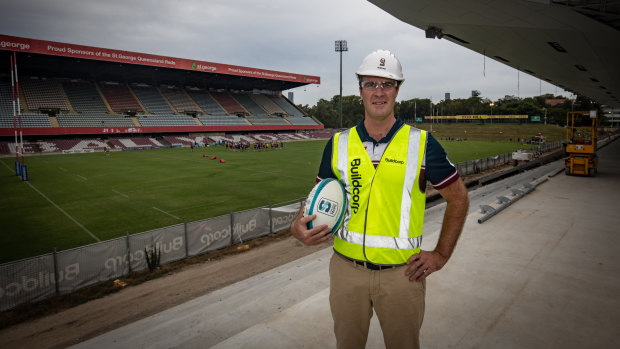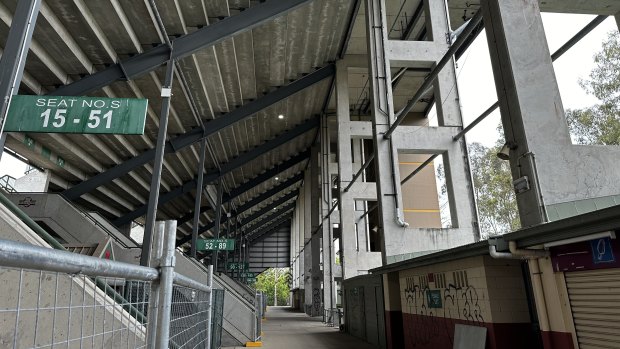This was published 2 years ago
Less is Ballymore: Capacity to be capped at 8000, short of Olympic needs
Another Olympic venue could end up costing more than anticipated, with revelations Brisbane 2032’s hockey venue needs more work than previously thought to be brought up to standard.
Ballymore, the home of Queensland rugby, was selected as the main hockey venue for the Olympic hockey competition, with a new western stand under construction as part of the new $30 million National Rugby Training Centre.

QRU chief executive David Hanham at Ballymore this week, with the eastern stand to the left of the picture.Credit: Brendan Hertel/QRU Media
The 3010-seat stand, which included 410 in corporate hospitality, is nearing completion, with the Queensland Rugby Union expecting to collect the keys in late May for a June opening.
But QRU chief executive David Hanham said even with the new facility’s completion, the Herston stadium would be a long way from finished.
The 4670-seat eastern stand was no longer considered safe for use, Hanham said, which meant Ballymore’s capacity would be capped at 8000 when it reopened in June.
That would fall short of the International Hockey Federation’s (FIH) requirements for a 10,000-seat main Olympic competition venue.
No costings have been done, but the QRU believes it may be cheaper to start over, rather than refurbish the 30-year-old stand.

Beneath Ballymore’s eastern stand.Credit: Cameron Atfield
“We have two options for the next phase: we either renovate the stand as it sits, or we replicate what we’ve done with the National Rugby Training Centre on the other side,” Hanham said.
Given rising construction costs, that could add more than $30 million to the cost of getting Ballymore Olympic-ready.
Whichever option got the green light, Hanham said the QRU aimed to have work done in time for the 2032 Games.
Hanham said a new eastern stand could be built within 18 months of a decision being made.
Last year, Deputy Premier Steven Miles said Ballymore was chosen to host the Olympic hockey because it was an existing venue, with the necessary upgrades underway.
The purported state of the eastern stand, which Stadiums Queensland has recommended be demolished, suggests that might not be the case.
But a State Development Department spokeswoman insisted Ballymore could still host Olympic hockey without more major work.
“The vast majority of the seating set to be used during Brisbane 2032 will be temporary overlay, with some use of the western stand,” she said.
“The eastern stand seats are not required to meet the seating requirements of the hockey competition at the Games.”
It has been more than a decade since rugby fans packed the eastern stand, in a charity match between Wallabies and All Blacks greats in 2011 to raise money for Christchurch earthquake recovery. About 20,000 people squeezed into the ground for that match.
The new Ballymore’s first big test was expected to be an exhibition match between the Queensland Reds and Japanese side Saitama Wild Knights, while Brisbane Roar is in negotiations to play at the venue for the next A-League Men season.
“They want an intimate venue that creates atmosphere, which is what they’ve had at the Dolphins and what they’d like to see in Brisbane,” Hanham said of the Roar, which has been playing out of Redcliffe’s 11,500-capacity Kayo Stadium, where the club has attracted an average crowd of just 4666 this season.
While the stand would be closed to spectators, the concourse beneath, with “Ballymore” emblazoned across its maroon seats, would be open to spectators.
If taxpayers have to foot the bill for Ballymore, it would be small change compared with other Games venues.
The cost of Brisbane’s main Olympic venue, the Gabba, has already blown out by 170 per cent to $2.7 billion.